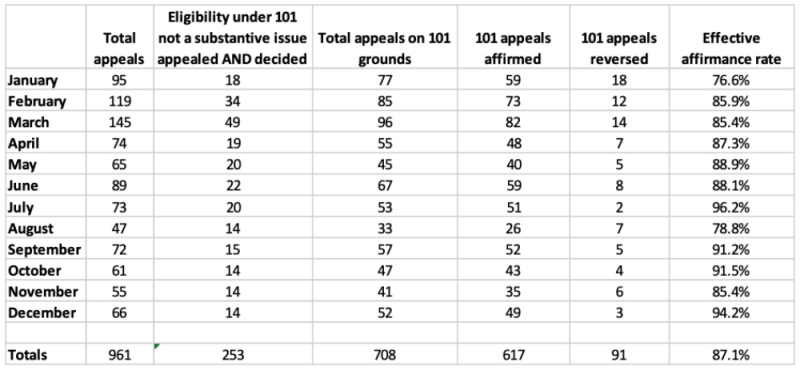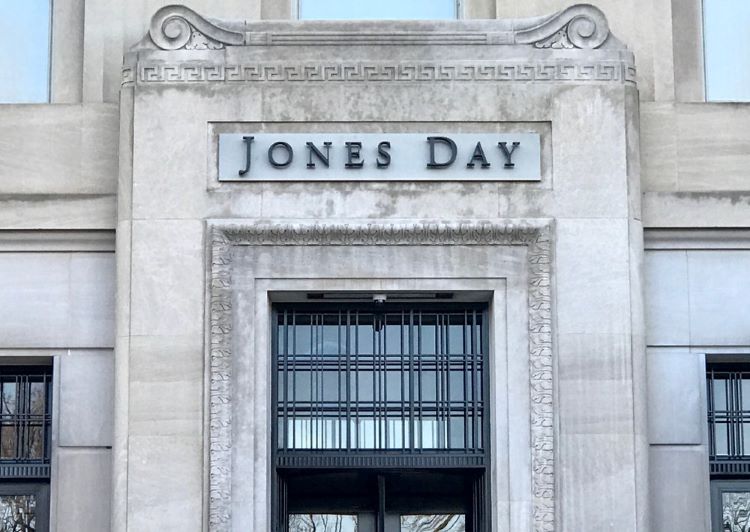Think Twice About Appealing a § 101 Rejection to the PTAB | McDonnell Boehnen Hulbert & Berghoff LLP
The U.S. Patent and Trademark Office (USPTO) established its Patent Trial and Appeal Board (PTAB) in September 2012. As mandated by the America Invents Act, the PTAB conducts administrative trials, such as inter partes reviews, and handles appeals from examiner rejections of patent applications.
Regarding the trials, former Federal Circuit Judge Randall Rader nicknamed the PTAB a “death squad” for patents, as PTAB judges were tasked with invalidating patents that had been duly issued by the examining corps. The accuracy of this moniker is debatable, as the latest published trial data for fiscal year 2022 indicates that only 34% of all patents undergoing such a trial eventually have at least some claims invalidated. But if we eliminate those for which the trial settled or was dismissed early for some reason, this number jumps to 49%. And if we only consider final written decisions, the number is 83%.
On the appeals side, the latest published appeal data for fiscal year 2022 indicates that the PTAB affirmed examiners 55.6% of the time, and affirmed examiners in part 9.1% of the time. Still, there has been growing anecdotal evidence that appeals of rejections made on grounds of subject matter eligibility — addressing the requirements of 35 U.S.C. § 101 as interpreted by the courts — had abysmally low win rates for applicants. Indeed, Professor Dennis Crouch published a short blog post stating that the PTAB affirmed examiners a whopping 92% of the time for § 101 appeals decided in the June/July 2021 time frame.
If true, this statistic should give us pause — applicants should be aware that their chances of winning a § 101 appeal are somewhere around that of the proverbial snowball in Hell. Also, USPTO administrators might want to determine why this number is so extreme.
Professor Crouch did not provide a description of his methodology for coming up with this 92%, though it appears that he used a third-party analytics tool. From experience, our gut instinct was that this affirmance rate is higher than expected, and that a larger data set would likely find it to be between 75% and 80%. So we decided to undertake that analysis.
We searched the USPTO’s PTAB decision database for all § 101 appeals decided in calendar 2021. When taking a first pass through the data, we found that it needed some filtering to be meaningful. Using the database’s search function resulted in just about any appeal that involved § 101 in some fashion.[1] Therefore, we only considered appeals that matched the following criteria:
1. The decision was published between January 1, 2021 and December 31, 2021.
2. The decision was not for a request for rehearing.
3. The appeal was over a § 101 rejection that invoked Alice Corp. v. CLS Bank Int’l, and not just a purely statutory or double patenting § 101 rejection.
4. The applicant appealed on grounds of § 101 and the PTAB rendered a substantive § 101 opinion. This eliminates cases where the applicant appealed a § 101 rejection, but the examiner subsequently withdrew the rejection, as well as cases where the applicant did not appeal on § 101 grounds but the PTAB provided new grounds of rejection on the basis of § 101.
5. For purposes of categorizing whether an examiner was affirmed, if the PTAB affirmed the examiner’s § 101 rejections on as little as one claim, we considered the examiner to be affirmed. In practice, relatively few decisions resulted in some claims being held ineligible and others eligible.
Once these criteria are applied, in theory we are left with three possible outcomes of each appeal: (i) the examiner is affirmed, (ii) the examiner is reversed, or (iii) the examiner’s § 101 rejections are reversed but the PTAB issues new grounds of rejection under § 101. In looking at the decisions, we did not identify any appeals falling into the third category, so the outcomes are either affirmance (applicant loses) or reversal (applicant wins).
Our results are in the table below, broken out by month. For each month, we provide the total number of appeals that came up in our search, and identify those that are disqualified according to our criteria. The remaining are the total appeals on § 101 grounds. These are broken out into those that were affirmed and those that were reversed. The effective affirmance rate is the number of § 101 appeals affirmed divided by the total appeals on § 101 grounds.
Jumping straight to the payoff — Professor Crouch’s one-month analysis is not far off for 2021 as a whole. In 2021, the PTAB affirmed § 101 rejections from examiners 87.1% of the time. Put another way, in about 7 out of every 8 such appeals, the applicant lost. All things the same, this gives the applicant about the same odds as drawing either three of a kind, a straight, or a flush in 7-card poker.
But the effective affirmance rate varied from month to month. It was at a low point in January (76.6%) and a high point in July (96.2%), though there was no clear month-over-month trend. For the most part, the percent hovered in the mid to high 80s. On the other hand, the number of total appeals on § 101 grounds trended downward throughout 2021, with the monthly average being 78.25 for the first four months of the year and 49.25 for the last four months of the year. This suggests that fewer applicants are filing appeals, probably due to the rather disappointingly low likelihood of obtaining a positive outcome.
So what does this mean for applicants? One obvious recommendation is to avoid appealing § 101 rejections to the PTAB unless you have a very strong case. Instead, try to work with the examiner to the extent possible. The problem with this approach, however, is that some examiners issue § 101 rejections on a regular basis and rarely withdraw such rejections. Sometimes, this reticence is based on gamesmanship rather than application of the applicable law.[2] Thus, applicants may be incentivized to file continuations or continuations-in-part in attempts to get another bite at the apple with a new (and hopefully more reasonable) examiner. Nonetheless, the best way of dealing with § 101 is avoiding having to deal with § 101 altogether. If possible, drafting claims and a specification that cover the technical aspects of the invention in a specific fashion that sets forth its advances over the prior art is the best way to dance around the Alice quagmire.
But our observations should be considered by USPTO administration as well. Is this level of examiner affirmance justifiable given that the affirmance rate for § 103 appeals is around 50%? Are these § 101 appeals for claimed inventions that clearly do not qualify as patent-eligible under Alice and the subsequent case law (e.g., do the claims lack a specific, technical improvement over the prior art)? Are PTAB judges under undue pressure to affirm or have they developed a culture that improperly favors affirmances? Are the judges fully considering the technical advances set forth in the claims and/or the specification? Are applicants’ analogies to patent-eligible cases being given the appropriate amount of weight?
The bottom line is not good news for anyone dealing with a § 101 rejection. The usual route that an applicant can take when at an impasse with an examiner is to appeal. But that route has been narrowed to a dirt road traversing the edge of a cliff with no guardrails . . . and there may be a death squad blocking your path.
[1] For example, a search by Proceeding Type (Appeal), Decision Type (Decision), and Issue Type (101) results in a list of cases that is overly inclusive and often containing some that had nothing to do with § 101 at all.
[2] We want to emphasize that the vast majority of examiners are honest, hardworking, and at the very least attempt to apply the law in a cogent, rational, and fair basis. Nonetheless, the vagary of § 101 in particular opens the door for shenanigans.






